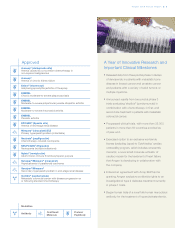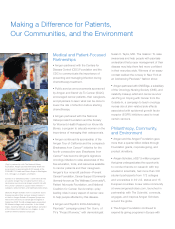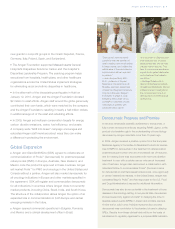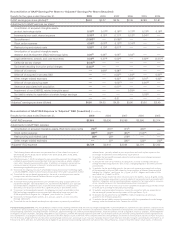Amgen 2009 Annual Report Download - page 17
Download and view the complete annual report
Please find page 17 of the 2009 Amgen annual report below. You can navigate through the pages in the report by either clicking on the pages listed below, or by using the keyword search tool below to find specific information within the annual report.patients with breast, non-small cell lung, head and neck, lymphoid and cervical cancers. As part of the
REMS, a medication guide explaining the risks and benefits of ESAs must be provided to all patients re-
ceiving ESAs. To ensure continued access to ESAs for healthcare providers who prescribe, or prescribe
and dispense, ESAs to patients with cancer, providers are required to train and enroll in the ESA AP-
PRISE (Assisting Providers and cancer Patients with Risk Information for the Safe use of ESAs)
Oncology Program and to document that a discussion about the risks of ESAs took place with each pa-
tient prior to the initiation of each new course of ESA therapy. The ESA APPRISE Oncology Program
will be launched on March 24, 2010. Direct patient registration or approval prior to ESA administration is
not required through the ESA APPRISE Oncology Program.
• On December 16, 2009, after consultation with the FDA, Amgen and Centocor Ortho Biotech Products
updated the safety information in the ESA product labeling to reflect certain results of our TREAT study.
These changes include a revision to the BOXED WARNINGS section to include the increased risk of
stroke and to reinforce the need to follow the approved label guidance to maintain Hb levels within the
range of 10 to 12 grams per deciliter (“g/dL”). (See discussion of Aranesp®TREAT study results in
“Research and Development and Selected Product Candidates.”)
• The FDA has announced that it will call an advisory committee meeting in 2010 to re-evaluate the use of
ESAs to treat anemia in patients with CKD and could consider lowering targeted Hb levels and reducing
approved dosing for ESAs.
• The CMS has scheduled a MEDCAC meeting for March 24, 2010 to examine currently available evi-
dence on the use of ESAs to manage anemia in patients who have CKD, which may consider the results
of the TREAT study. In February 2010, the CMS released the voting questions the MEDCAC will ad-
dress, including whether the available evidence in both CKD not on dialysis and ESRD clearly (i)
demonstrates benefits and risks of ESA therapy, (ii) supports a baseline Hb range or (iii) justifies a dose
response or maximum dose. The CMS will decide whether more evidence is needed to determine whether
ESA treatment is reasonable and necessary to support continued Medicare coverage. (See
“Reimbursement.”)
• On September 15, 2009, the CMS released its proposed rule to implement a bundled prospective payment
system for ESRD, which becomes effective in 2011 and could impact EPOGEN®. (See
“Reimbursement.”)
• We are working with the FDA to make ESA product package insert changes associated with the Phys-
ician’s Labeling Rule (“PLR”) conversion process. During the process of converting from the existing
format to the new PLR format, the FDA may evaluate the package insert information to ensure that it ac-
curately reflects current knowledge and may revise, add to or remove information appearing in the old
format that could substantively impact the content of the product package insert.
In addition to the above, following the Oncologic Drugs Advisory Committee (“ODAC”) meeting in May
2004, we proposed a pharmacovigilance program for Aranesp®comprised of five studies to explore the use of
ESAs in settings different from those outlined in the FDA approved label. These studies were subsequently des-
ignated by the FDA as PMCs. Of the five studies, one was sponsored by Amgen while the remaining four were
investigator-sponsored. Results of certain of these studies contributed to safety-related product labeling changes
for our ESA products and changes in reimbursement, as noted above. Of the five studies, three are complete
while final results of the other two are expected in 2010 or 2011. In addition, Johnson and Johnson Pharmaceut-
ical Research & Development (“J&JPRD”), a subsidiary of J&J, and/or its investigators have conducted
numerous studies proposed at the 2004 ODAC meeting. All of these studies are closed to enrollment and sum-
mary results were submitted to the FDA. In addition, J&JPRD’s EPO-ANE-3010 study in breast cancer is
ongoing and is designated as a FDA PMC.
Based on our ongoing discussions with the FDA in response to the May 2007 ODAC meeting, we and
J&JPRD have carefully considered potential new study designs to determine the effects of ESAs on survival and
tumor outcomes in anemic patients with metastatic cancer receiving concomitant myelosuppressive chemo-
therapy. Based on these discussions, we have initiated a randomized, double-blind, placebo-controlled, phase 3
5
























